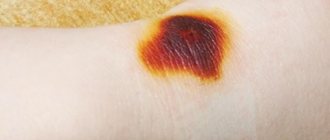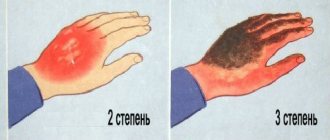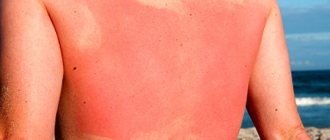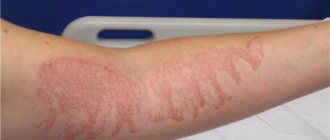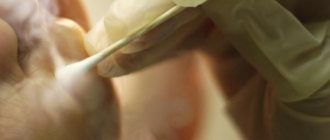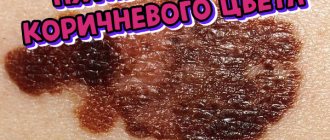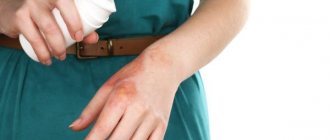Acetic acid burn: pathogenesis
The cause of burns from acetic acid is mainly careless handling of the solution. A particularly high concentration of the substance causes immediate damage to organs. Lesions can be of two types:
- External. When it comes into contact with a person’s external organs, the acid causes immediate corrosion of the skin or mucous membranes. And without first aid, complications may arise that will lead to longer treatment.
- Internal. Such injuries pose a particular danger to humans. The penetration of acetic acid into internal organs has serious consequences and requires immediate medical treatment.
Severe burns from a highly concentrated solution can cause death to the victim.
Degree of acetic acid burn
The nature of the damage depends on the amount and concentration of acetic acid ingested and the duration of contact with it.
There are different degrees of burns:
- First. Refers to mild lesions. It is characterized by superficial redness of the skin tissue, which may be accompanied by swelling and pain. In most cases it is treated quite quickly. After therapeutic actions there are no traces of burns left.
- Second. Along with the top cover, the germ layer of the epidermis is damaged. The formation of blisters on the skin is observed, which subsequently form a wound. Healing occurs over several weeks.
- Third. A deeper lesion, covering all layers of the skin. The wound consists of purulent discharge, clotted blood and dead cells. Requires long-term hospital treatment, the success of which depends on the first actions after the burn. Such injuries leave scars and scars.
- Fourth. The most dangerous form of pathology. Occurs upon contact with a strong acid solution. With such lesions, all skin cells die. The success of treatment depends on the size of the affected areas and the characteristics of the patient’s immune defense.
In the most severe cases, first aid and the timely arrival of an ambulance can save the victim’s life.
Features of development and manifestations
When acetic acid comes into contact with the tissues of the human body, it corrodes them in a matter of minutes, so the victim needs help immediately. If this trouble occurs to a child, you must urgently take him to the hospital.
An internal burn with acetic acid can be fatal for both a child and an adult; only doctors can save such a patient.
In addition, the concentration of vinegar can vary, from 6% to a stronger solution called vinegar essence (80%). Burns to the legs, feet and other parts of the body occur upon contact with any of these liquids, but the higher the percentage of acetic acid, the more serious the injury and the more dangerous its consequences.
Symptoms of internal damage
An external burn with vinegar appears immediately after this substance gets on the skin; a person will see a white spot on the skin, which will turn gray after a few minutes. The manifestations of such an injury are very vivid; pain and burning of the affected area occurs, which become very intense.
If the burns affect the mucous tissue of the esophagus or throat, then the problem is much more serious, since the destructive effect of vinegar is enhanced by the hydrochloric acid contained in this area of the body.
Symptoms of a laryngeal burn:
Symptoms depending on the location of the burn
Acetic acid can get on both external and internal human organs. Damage to different parts of the human body has distinctive symptoms.
Leather
A light spot initially forms on the area burned with acid. It quickly darkens and acquires a gray tint. The injured area of the skin begins to hurt and a burning sensation is felt.
The skin becomes dry and a crust appears with clear contours that separate healthy and diseased tissue.
Acetic acid burn: oral cavity
If a solution of strong concentration comes into contact with the solution, severe pain and tissue damage occurs. The oral cavity turns white and begins to swell. There is copious secretion of saliva. Speech becomes difficult.
Acetic acid burn: larynx
The first sign of a burn to the larynx is a sharp pain and burning sensation. Vomiting and strong secretion of salivary gland secretions begin. The lips and oral cavity swell. Body temperature rises and lymph nodes enlarge.
The first sign of a burn to the larynx is a sharp pain and burning sensation.
Severe injuries can cause suffocation for the victim.
Acetic acid burn: esophagus
A burn to part of the digestive canal causes pain in the chest, neck and upper abdomen. This is due to the fact that internal organs have many nerve endings.
Damage to the esophagus is accompanied by nausea and vomiting. The tissues of the organ swell, affecting the vocal cords. Such symptoms interfere with normal swallowing of saliva and negatively affect the victim’s speech. Body temperature increases.
Airways
Acetic acid enters the respiratory system in the form of hot vapors. The nature of the lesions depends on the saturation of the inhaled solution. The first signs of a burn are a suffocating, continuous cough and runny nose. Tears begin to flow and it becomes difficult to breathe air.
The first signs of a burn are a suffocating, continuous cough.
With severe damage from acetic acid, intoxication of the human body occurs, which can cause a state of shock. In such cases, signs of acute toxic psychosis, shortness of breath and tachycardia are often observed. Over time, concomitant diseases appear - pancreatitis, gastritis or pneumonia. The body's protective functions are significantly reduced.
Chemical burn of the esophagus after accidental ingestion of vinegar 6%
Elena, Salekhard
February 25, 2020
Hello! On February 22, 2020, at approximately 9:00 pm, I accidentally took balsamic vinegar 6%. Because the bottle and color of the liquid look like soy sauce, vinegar was poured into the sauce boat by mistake, and I dipped the roll in this sauce and managed to eat it. I dipped it generously, I assume that perhaps the volume of vinegar taken was about a teaspoon. I’m afraid that the following factors could have aggravated the situation: before that I took white sparkling wine (about 2 glasses), and after that, about another 1.5-2 glasses (because at first I didn’t give much importance to what happened) so- continued eating. As soon as I swallowed the roll, I felt a taste of vinegar and a burning sensation, which went away quite quickly. After about 1-1.5, I had a sour aftertaste (this usually happens after wine), but I was afraid that I could burn my esophagus with vinegar. After about 1-1.5 hours, I called an ambulance, they told me that I needed to drink liquid and take Almagel (if available) or Omeprazole. There were no medications in the home medicine cabinet, and being frightened, I began to drink a lot of water, I drank so much that I vomited, I am very afraid that this is the second factor that could aggravate the situation. Because I read that in case of a chemical burn, you should never induce vomiting. On the trail. day appeared, discomfort when eating (feeling of swelling), pain in the throat, and in the retrosternal area, extending to the back (between the shoulder blades), also a dry cough, as if something was bothering. With more intense breathing, you also feel discomfort and pain in the stomach and to the right of it. I called the ambulance again and they told me there was nothing to do. On February 24, I went to the emergency room and was prescribed Almagel 4 times a day after meals for 14 days, omeprazole 20 mg, 2 times a day before meals for 14 days, and Mezim after meals for 7 days, only on the second day they told me what I needed follow a diet(((and without knowing this, after sleep I took solid food, moreover, I took the medications prescribed by the gynecologist and other doctors: Isoprinosine 2 tablets, Vitamin D 10000 IU 1 capsule, Detralex 1000 mg, Dihydroquercetin 1 tablet. Temperature on the second day bvla 37.4. Today, February 25 (day 3), the symptoms persist, moreover, at night they became even stronger in the stomach area, an acute throbbing sensation appeared. And to the right of the stomach too. Today I spoke with my relatives on the phone for about 40 minutes, and my throat hurt again and in the substernal area the pain has intensified and radiates to the back (between the shoulder blades). When I take food, I directly feel how it goes into the stomach, the pain immediately radiates sharply in the stomach (((We have a very small city, as it turns out, there is no gastroenterologist ((I'm scared and in complete confusion, please tell me what should I do next? I am very afraid that scarring will begin in the esophagus and stomach, stenosis. 1) First of all, I am interested in what measures need to be taken now to prevent the formation of scars? Bougienage? Glucortecosteroids? Physiotherapy (darsonval, laser, etc.)? Are these methods effective? What else can you do? 2) How can you correctly determine the degree of burn? 3) How many days after a chemical burn can gastroscopy be done? Now you can’t do it while the esophagus and stomach are irritated? Is it possible to further damage the esophagus with an endoscope during examination? 4) Is ultrasound informative? After all, this would be a gentle diagnostic method. 5) Could the wine and vomiting have made the situation worse? And the fact that, in addition, for the first day I took solid food and medications: Isoprinosine 2 tablets, Vitamin D 10000 IU 1 capsule, Detralex 1000 mg, Dihydroquercetin 1 tablet 6) I am already following a diet, but before that I took a course of medications: Detralex 1000 mg, Dihydroquercetin, Isoprinosine 500 mg, 2 t. 2 times a day, is it possible to continue taking these drugs now? How long should you follow the diet in such a situation? 7) Is it advisable and will it not harm taking the already prescribed drugs: Almagel (yellow they said), first green saw, omeprazole ro 20 mg 2 times a day, and mezim 3 times a day after meals? Is it true that scars form from 1-4 months to 3 years? Sorry for the many questions! Help please, it's very scary(((
On February 22, 2020, at approximately 9:00 pm, I accidentally took balsamic vinegar 6%. Because the bottle and color of the liquid look like soy sauce, vinegar was poured into the sauce boat by mistake, and I dipped the roll in this sauce and managed to eat it. I dipped it generously, I assume that perhaps the volume of vinegar taken was about a teaspoon. I’m afraid that the following factors could have aggravated the situation: before that I took white sparkling wine (about 2 glasses), and after that, about another 1.5-2 glasses (because at first I didn’t give much importance to what happened) so- continued eating. As soon as I swallowed the roll, I felt a taste of vinegar and a burning sensation, which went away quite quickly. After about 1-1.5, I had a sour aftertaste (this usually happens after wine), but I was afraid that I could burn my esophagus with vinegar. After about 1-1.5 hours, I called an ambulance, they told me that I needed to drink liquid and take Almagel (if available) or Omeprazole. There were no medications in the home medicine cabinet, and being frightened, I began to drink a lot of water, I drank so much that I vomited, I am very afraid that this is the second factor that could aggravate the situation. Because I read that in case of a chemical burn, you should never induce vomiting. On the trail. day appeared, discomfort when eating (feeling of swelling), pain in the throat, and in the retrosternal area, extending to the back (between the shoulder blades), also a dry cough, as if something was bothering. With more intense breathing, you also feel discomfort and pain in the stomach and to the right of it. I called the ambulance again and they told me there was nothing to do. On February 24, I went to the emergency room and was prescribed Almagel 4 times a day after meals for 14 days, omeprazole 20 mg, 2 times a day before meals for 14 days, and Mezim after meals for 7 days, only on the second day they told me what I needed follow a diet(((and without knowing this, after sleep I took solid food, moreover, I took the medications prescribed by the gynecologist and other doctors: Isoprinosine 2 tablets, Vitamin D 10000 IU 1 capsule, Detralex 1000 mg, Dihydroquercetin 1 tablet. Temperature on the second day bvla 37.4. Today, February 25 (day 3), the symptoms persist, moreover, at night they became even stronger in the stomach area, an acute throbbing sensation appeared. And to the right of the stomach too. Today I spoke with my relatives on the phone for about 40 minutes, and my throat hurt again and in the substernal area the pain has intensified and radiates to the back (between the shoulder blades). When I take food, I directly feel how it goes into the stomach, the pain immediately radiates sharply in the stomach (((We have a very small city, as it turns out, there is no gastroenterologist ((I'm scared and in complete confusion, please tell me what should I do next? I am very afraid that scarring will begin in the esophagus and stomach, stenosis. 1) First of all, I am interested in what measures need to be taken now to prevent the formation of scars? Bougienage? Glucortecosteroids? Physiotherapy (darsonval, laser, etc.)? Are these methods effective? What else can you do? 2) How can you correctly determine the degree of burn? 3) How many days after a chemical burn can gastroscopy be done? Now you can’t do it while the esophagus and stomach are irritated? Is it possible to further damage the esophagus with an endoscope during examination? 4) Is ultrasound informative? After all, this would be a gentle diagnostic method. 5) Could the wine and vomiting have made the situation worse? And the fact that, in addition, for the first day I took solid food and medications: Isoprinosine 2 tablets, Vitamin D 10000 IU 1 capsule, Detralex 1000 mg, Dihydroquercetin 1 tablet 6) I am already following a diet, but before that I took a course of medications: Detralex 1000 mg, Dihydroquercetin, Isoprinosine 500 mg, 2 t. 2 times a day, is it possible to continue taking these drugs now? How long should you follow the diet in such a situation? 7) Is it advisable and will it not harm taking the already prescribed drugs: Almagel (yellow they said), first green saw, omeprazole ro 20 mg 2 times a day, and mezim 3 times a day after meals? Is it true that scars form from 1-4 months to 3 years? Sorry for the many questions! Help please, it's very scary(((
The question is closed
Providing first emergency aid
Correctly provided assistance in the first minutes of a burn field not only promotes rapid healing of wounds, but can also save the life of the victim.
For external burns
If vinegar gets on the outside of your body, the first step is to remove clothing from the affected area. Subsequent actions for vinegar burns consist of the following steps:
- burned areas are washed with cold water for 20 minutes;
- the skin is treated with soda or soap solution dissolved in water;
- after cleansing the affected area, wash off with clean cool water;
- an antiseptic and anti-inflammatory agent is applied;
- a dry sterile bandage is applied.
If you burn with acetic acid, do not forget to apply a dry, sterile bandage.
For minor injuries, the main goal of first aid is to relieve pain, redness and swelling. You can continue to treat such injuries at home. Serious injuries require immediate hospitalization.
For internal burns
When acetic acid gets ingested, the main task is to immediately neutralize the toxic substance.
If the solution falls into the throat, rinse all affected areas, including the oral cavity, with baking soda diluted in water. A burn to the esophagus requires more complex measures. In addition to rinsing, immediate gastric lavage is required. For this, more than five liters of clean water are used. You should not give the soda solution to the victim to drink; such a mixture can further destroy the affected tissue areas.
Internal burns are much more dangerous than external injuries caused by acetic acid. Therefore, after providing first aid, professional examination and treatment are required.
What to do if you get a vinegar burn?
- external;
- internal.
In the first case, the acid gets on the skin, face, mucous membranes, hands - that is, on the human body. Particularly sharp pain is caused by the essence getting into the eyes.
Internal injury can be caused by swallowing vinegar. The solution burns the larynx, esophagus, and stomach. This damage is especially dangerous if the victim has gastrointestinal diseases.
To avoid burns, you should handle vinegar and its derivatives carefully. However, if an accident has already occurred, it is necessary to immediately provide assistance to the victim.
Even if a person burned with acid is at home alone, but knows the principles of first aid for a burn with vinegar, he can significantly relieve the pain and reduce the depth of the injury. Of course, it will be even better if someone is nearby.
Acetic acid burn: diagnosis
The nature of an external burn can be determined by changes in the color of the skin and the specific smell of the affected area. Based on external indicators, wounds are assessed and the degree of the pathological process is determined. The situation with internal burns is somewhat more complicated.
To establish intoxication of the body with acetic acid, anamnesis data are initially collected, including a visual examination of the patient. The main indicator of a burn of internal organs by vinegar is the presence of a characteristic odor from the oral cavity.
To establish the final diagnosis and the extent of the lesion, a general blood test is prescribed.
To establish the final diagnosis and the extent of the lesion, the following additional study is prescribed:
- a general blood test that determines the level of ESR and C-reactive protein;
- fluoroscopic examination.
If the mucous membrane of the eyes is damaged, an additional consultation with an ophthalmologist is carried out.
Rules for therapy
In the case of mild injuries to small areas of the body in adults, treatment of chemical skin burns can be done at home. The patient can resort to the use of both medications and folk remedies. If a child suffers such an injury of any severity, consultation with a doctor is mandatory .
Medicines
To speed up skin regeneration and prevent secondary infection, it is recommended to use the following drugs:
- Chlorhexidine is a popular antiseptic, with which it is necessary to periodically treat the damaged area of the body,
- Panthenol - ointment is applied to burned areas several times a day. It helps speed up the recovery of the skin and relieves pain,
- Levomekol is a drug with an antibacterial effect that prevents secondary infection of the wound and accelerates healing,
- Rescuer - has disinfecting properties and stimulates the restoration of the skin.
Treatment depending on the location and degree of the burn
Treatment methods are determined by the severity of the damage. For both internal and external lesions, the first step is to eliminate pain, and also take measures to stop the pathological process.
External burns
If the skin is damaged by acetic acid, the area is initially disinfected with antiseptic agents. In parallel with this, healing ointments are used.
For higher degree burns, antibiotics and antihistamines are prescribed. Serious injuries are accompanied by intense pain that can cause shock. In such cases, painkillers and antispasmodics are necessarily prescribed.
The most effective medications against burns include the following ointments:
- "Levomekol";
- "Panthenol";
- "Dermazin";
- "Rescuer";
- "Solcoseryl".
The most effective medications against burns include levomekol.
The duration of therapy depends on the size of the affected tissue and the degree of the burn. When all tissues of the skin or mucous membranes are affected, surgical intervention is sometimes necessary. The operation is aimed at removing dead tissue. After this, plastic surgery can be performed.
The burn site should not be treated with iodine, brilliant green or preparations containing alcohol. Such substances contribute to greater destruction of skin tissue.
Internal burns
Internal organ damage has another treatment:
- Oral cavity. The doctor prescribes antiseptics as a rinse and treatment of sore areas with wound-healing ointments. Solcoseryl Denta dental paste helps well in such cases. For severe pain, painkillers are taken.
- Larynx. Treatment is with antihistamines, which help reduce swelling of the throat. Medicines are also used to relieve pain symptoms. Antispasmodics are prescribed along with them.
- Esophagus. Treatment of such damage to the tissues of the digestive part cannot be done without pain-relieving drugs, bacteria-killing drugs and antispasmodics. For severe burns of the esophagus, additional therapy for the cardiac and respiratory systems is required.
Along with drug therapy, the patient is prescribed a special diet. If the larynx and organs of the digestive tract are affected, it is recommended to consume soups or pureed foods.
Therapeutic actions should be carried out immediately after the injury. Six hours after a vinegar burn, therapy may no longer be effective. Therefore, it is especially important to consult a doctor in a timely manner for help.
Traditional methods of treatment
For burns with acetic acid, various traditional methods of therapy are successfully used, which accelerate the healing process of damaged tissues and have a softening and calming effect.
The most effective alternative medicines include:
- Oak bark. Pour 3 tablespoons of crushed oak bark into a container with one liter of water and cook over low heat for 30 minutes. Cool the finished broth and strain. Liquid is used for compresses. It should only be used freshly prepared.
- Potato. Peel the vegetable and grate it on a fine grater. Apply the resulting potato mass to the affected skin for 25 minutes. This procedure should be repeated twice a day.
- Hornbeam elm. Add one tablespoon of finely chopped elm bark to 200 milliliters of water. Boil the solution for 20 minutes over low heat. Use the cooled and strained broth for lotions. Apply the product to the wound at least three times a day.
- Aspen bark. Pour one tablespoon of crushed bark into a container with a lid and pour 400 milliliters of boiling water. Let the mixture sit for an hour. After this, the liquid saturated with aspen bark must be filtered and diluted with a glass of boiled water. Take the infusion three times a day, two tablespoons at a time. The medicine should be taken with meals.
- Mint. Pour a tablespoon of finely chopped mint into 200 milliliters of hot water and leave in a container with the lid closed to steep for 45 minutes. The strained solution is used to make lotions three times a day.
- Aloe. Squeeze the juice from the leaves of the plant, which is used to treat damaged areas of the skin. You can also apply aloe leaves, cut lengthwise with the fleshy side, to the wound.
- Beeswax. The waste product of bees is added to the butter in a 3:1 ratio. Stir the mixture in a water bath until the ingredients are completely dissolved. The cooled ointment is applied to the areas burned with vinegar, a gauze bandage is placed on top and left for two hours.
Traditional methods of treatment are used only for first-degree burns that do not have purulent formations and damage to the lower layers of the epidermis. For severe injuries caused by acetic acid, drug therapy is required, which is prescribed by a doctor. Self-treatment of such burns can lead to complications.
Prevention
The main objective of preventive measures is to comply with safety rules when using acetic acid, which include:
- storing concentrated vinegar out of the reach of children;
- use gloves when diluting high concentration acid.
The container with vinegar must have a label indicating the name of the substance. If acid accidentally comes into contact with your skin, you should immediately take all necessary measures to reduce its effect on the body. See a doctor immediately after getting a burn.
First aid
If acid gets on clothing, it is necessary to remove it as quickly as possible - this will reduce the impact of the traumatic factor on the body. To neutralize the activity of the chemical, you should rinse the affected area with plenty of running water, placing it under running water for 15-20 minutes. This will remove aggressive particles from the skin and reduce the degree of burn.
Further algorithm for providing first aid:
- Treat the skin with soda or soap solution, which neutralizes acetic acid. On small burns, you can apply a paste of baking soda and a few drops of water.
- Apply a damp compress to the damaged area. You must first make sure that the skin is thoroughly washed, otherwise the likelihood of damage to the deeper layers of the dermis increases.
- If the lesion is serious, occupies a large area and is accompanied by intense pain, you should consult a doctor. The specialist will prescribe appropriate treatment that will promote a quick recovery.
- It is strictly forbidden to smear a burn with vinegar with brilliant green, iodine or other alcohol-containing products: such actions lead to even greater injury to the epidermis.
Forecast
In case of mild tissue damage from acetic acid, after first aid, the patient is sent for home treatment. In such cases, healing occurs quickly and no trace remains of the burn.
Severe injuries, which are characterized by third and fourth degrees, have a mortality rate of 60 percent. The result of treatment depends on the amount of damage and the quality of care provided in the first minutes after the burn. Acid injuries to internal organs are especially dangerous.
An eye burn with a mildly saturated vinegar solution has a favorable prognosis. If measures were quickly taken to eliminate the acid, then 90 percent of vision is not impaired. With severe burns of the mucous membrane of the eye, solders often form, which lead to blindness.
An acid burn is a dangerous injury that can significantly harm a person’s health. To avoid irreparable consequences, you should carefully use the vinegar solution, especially in high concentration. In case of accidental damage to the skin or other organs, even mildly, you should immediately consult a doctor. Prompt assistance from a specialist can save not only your health, but also your life.
Symptoms of damage to different parts of the body
The list of symptoms from the effects of vinegar on the body depends on the area of the skin that was injured, its area and the duration of contact with the acid. It happens that unpleasant signs do not appear immediately, but only after some time. This happens especially often when acid has spilled onto clothing that has been in contact with the skin for quite a long time.
Without proper and timely assistance, a vinegar burn can lead to the death of a person if a large area of the body is affected.
Face
The consequence of contact with the essence of the skin on the face is usually the formation of a scab. This is a thin but dense crust that prevents the penetration of aggressive chemicals into the deeper layers of tissue.
With a mild burn, redness and swelling appear on the skin. If blisters filled with cloudy fluid develop, you should consult a doctor. This indicates damage to the deeper layers of the epidermis.
Esophagus
Injury to the esophagus occurs when a person swallows an aggressive substance. This is the most difficult situation and poses a danger to life. In these circumstances, immediate hospitalization of the victim is necessary. A lethal dose is considered to be 40 ml of 70% essence.
When this substance is ingested, the following symptoms develop:
- severe burning pain
- loss of voice,
- swelling of the mouth and esophagus,
- suffocation,
- pain shock,
- heart dysfunction,
- poor health, weakness,
- nausea, vomiting with blood,
- increase in body temperature.
The destructive effect of vinegar essence in the stomach is enhanced by the presence of hydrochloric acid in it. For severe injuries to the esophagus, surgical intervention is used.
Eyes
If an aggressive chemical gets into your eyes, you may experience:
- acute pain,
- tearfulness,
- photophobia.
Without proper and timely assistance, a person may lose his sight.
Oral cavity
A burn of the oral mucosa with vinegar is expressed by the presence of the following symptoms:
- sharp pain
- decreased sensitivity of taste buds,
- severe swelling, making swallowing difficult,
- increase in body temperature,
- rapid deterioration in general health.
